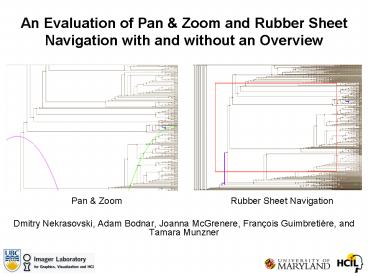An Evaluation of Pan
1 / 29
Title: An Evaluation of Pan
1
An Evaluation of Pan Zoom and Rubber Sheet
Navigation with and without an Overview
Pan Zoom
Rubber Sheet Navigation
- Dmitry Nekrasovski, Adam Bodnar, Joanna
McGrenere, François Guimbretière, and Tamara
Munzner
2
Motivation
- Problem Help make sense of large datasets
- Solution Interactive Visualization!
- Challenge Efficient navigation techniques
3
Conventional Pan Zoom (PZN)
- Navigation via panning (translation) and zooming
(uniform scale changes) - Easy to lose context and become lost
Selecting region to zoom
Zooming result
4
Overviews
- Separate global view of the dataset
- Maintain contextual awareness
- Force attention split between views
5
Rubber Sheet Navigation (RSN)
- Focus Context technique
- Stretching and squishing rubber sheet metaphor
- Maintain contextual awareness in single view
Selecting region to zoom
Zooming result
6
Previous Findings Mixed
- Mixed results for navigation and overviews
- Speed FC faster than PZN
- Schaffer et al., 1996 Gutwin and Skopik, 2003
- Accuracy PZN more accurate than FC Hornbaek
and Frokjaer, 2001 Gutwin and Fedak, 2004 - Preference Overviews generally preferred Beard
and Walker, 1990 Plaisant et al., 2002
7
Goals
- Evaluate RSN navigation technique
- Clarify utility of overviews for navigation
- Why add overview to FC?
- Need evidence to support or refute common InfoVis
assumption regarding usefulness of overviews
8
Motivating Domain
- Evolutionary biologists model relationships
between species as large tree datasets - Large datasets and clear tasks
- Requires understanding of topological structure
at different places and scales - Efficient navigation techniques
Munzner et al., 2003
9
Dataset
- 5,918 node binary tree
- Leaves are species, internal nodes are ancestors
- Labels removed
- Surprisingly seldom used
- More interested in topological structure
10
Task
- Generalized version requiring no specialized
knowledge of evolutionary trees - Compare topological distance between marked nodes
- Requires multiple navigation actions to complete
- Several instances isomorphic in difficulty
11
Experiment Interfaces
- Common visual representation and interaction
model - Lacking in majority of previous evaluations
- Common set of navigation actions
- Guarantee visibility of areas of interest
12
RSN
13
PZN
14
RSN Overview
15
PZN Overview
16
Guaranteed Visibility
- PZN
- Implemented in PZN similarly to Halo
- Baudisch et al., 2003
- RSN
- Implicit as areas of interest compressed along
bounds of display - Sub-pixel marked regions always drawn using
PRISAD framework - Slack et al., 2005
17
Hypotheses
- 1 - RSN performs better than PZN independent of
overview presence - 2 - For RSN, presence of overview does not
result in better performance - 3 - For PZN, presence of overview results in
better performance
18
Design
- 2 (navigation, between) x 2 (presence of
overview, between) x 7 (blocks, within) - Each block contained 5 randomized trials
- 40 subjects, each randomly assigned to each
interface
19
Procedure and Measures
- Training protocols used to train subjects in
effective strategies to solve task - Subjects completed 35 trials (7 blocks x 5
trials), each isomorphic in difficulty - Completion time, navigation actions, resets,
errors, and subjective NASA-TLX workload
20
Results - Navigation
- PZN outperformed RSN
- (p lt 0.001)
- Learning effect shows performance plateau
- Subjects using PZN performed fewer navigation
actions and fewer resets - Subjects using PZN reported less mental demand (p
lt 0.05)
21
Results Presence of Overview
- No effect on any performance measure
- Subjects using overviews reported less physical
demand and more enjoyment (p lt 0.05)
22
Summary of Results
- 1 - RSN performs better than PZN independent of
overview presence - No PZN outperformed RSN
- 2 - For RSN, presence of overview does not
result in better performance - Yes No effect of overview on performance
- 3 - For PZN, presence of overview results in
better performance - No No effect of overview on performance
23
Discussion Navigation
- Performance differences cannot be ascribed to
unfamiliarity with the techniques - Design guidelines for PZN extensively studied,
but not so for FC or RSN
24
Discussion Overviews
- Overviews for PZN and RSN
- No performance benefits
- Preference for overview
- Overview may act as cognitive cushion
- Provide subjective but not performance benefits
- Guaranteed visibility may provide same benefits
as overviews
25
Future Work
- Investigate methods of providing contextual
information with guaranteed visibility - Explore patterns of overview use though eye
tracking technology - Interact vs. glance vs. ignore
26
Conclusions
- Presented first evaluation comparing PZN and RSN
techniques with and without an overview - Performance
- PZN faster and more accurate than RSN
- Preference
- Overviews preferred, but no performance benefits
27
Acknowledgements
- David Hillis and research group from University
of Texas at Austin for discussions and dataset - James Slack from University of British Columbia
for help with the PRISAD framework - NSERC and NSF for funding
28
Backup Slides
29
Level of Context
PZN
RSN































